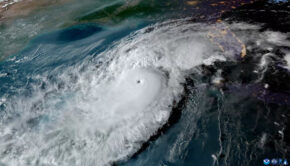The unforgettable storm of 1948
Published on July 25th, 2019
When our favorite octogenarian contributor, Donald Street, read about the storm that hit the 2019 Larchmont Junior Race Week, he reflected back on an unforgettable moment from his teenage years.
Having spent the first 27 years of my life on Manhasset Bay in Port Washington, NY, I was very surprised to hear of a bad squall approaching from New York City to the west rather than from the Westchester Hills to the north of Long Island Sound.
I well remember the famous 1948 squall that hit mid-afternoon on July 4, capsizing every centerboard boat in Western Long Island Sound, sinking three or four Stars who could not get their main halyards to unlock, reducing all the IODs Atlantics, 210, and other keelboats down to jib only.
No one had an accurate count of the number of sailors in the water. Low estimate 900, high estimate 1,200. This was before centerboard boats were self-rescuing, life jackets in centerboard boats, or sailors wearing full kit of foul weather gear.
Instead, every boat was required to carry one floatable cushion per crew member, and foul weather gear, if the sailor had any, was usually a light jacket that was less than water proof.
However, the most important lifesaving feature was the fact that in all junior sailing programs, before you could set foot in a boat, had each student prove they could swim 50 yards, two length of a 25 yard swimming pool, without stopping.
Also by mid-June, Western Long Island Sound water was warm enough such that hypothermia was not a problem
As the squall passed, every power boat, club launch, local police boat, the few Coast Guard small boats in the area, and every leisure boat in the area on their July 4 cruise, started retrieving sailors from the capsized boats.
One major problem was getting the kids to abandon the boat and climb on board the rescue boat as the sailing instructors universally had been telling students” stick with the boat, we will tow you in.”
While the squall was still on with very heavy rain, a couple for Lightnings were found turtled with no crew. In each case, luckily one of the rescue crew rapped on the bottom of the Lightning, and moments later three heads popped up.
The crews had decided that it was easier to stay inside the boat in the air pocket than try to hang on to the upside down lightning. The centerboard had dropped into the center board trunk. Thus the rudder was the only thing to hang on to, so inside they went.
Amazingly only two sailors were lost. Both were over 50 and it is believed they died of heart failure rather than drowning. Club launches and volunteers spent the rest of the week towing in capsized boats and trying to find the owners.









 We’ll keep your information safe.
We’ll keep your information safe.